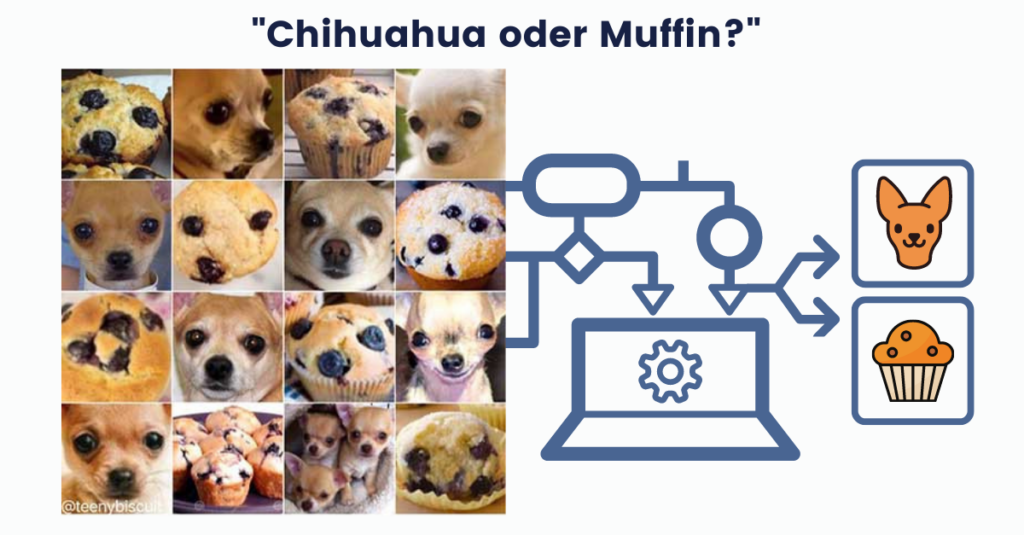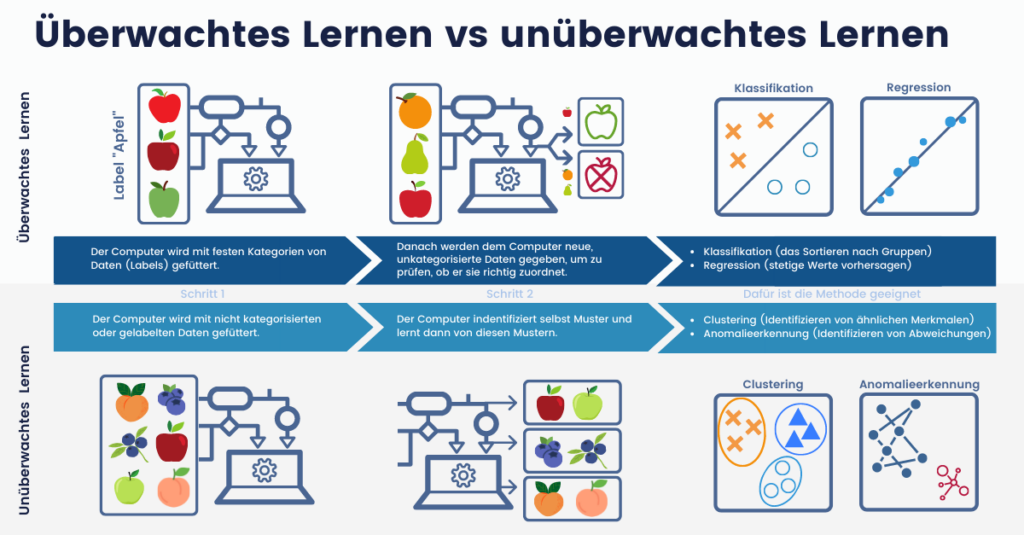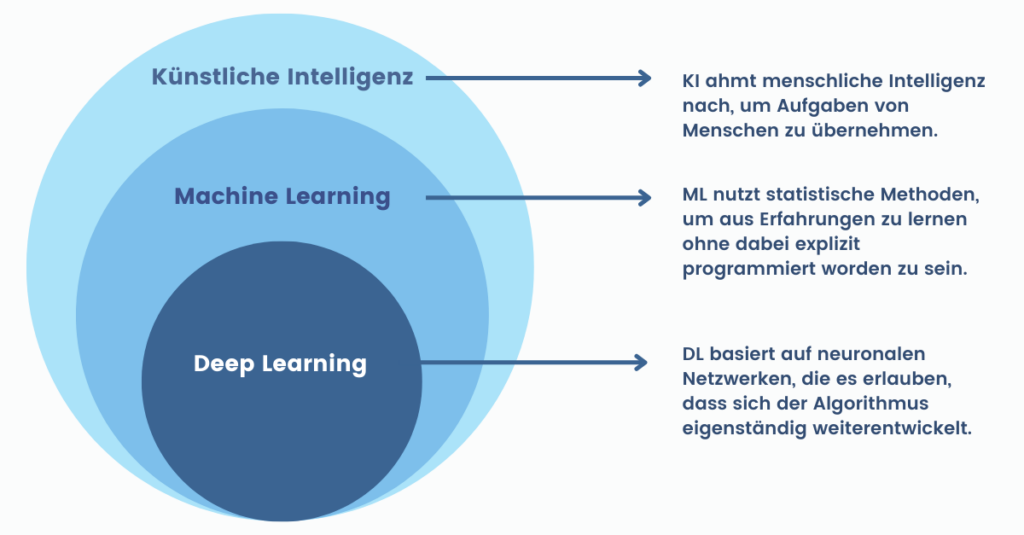When a computer imitates the human way of learning, we talk about machine learning.
How did machine learning come about? Stimulated and inspired by neuronal processes in the brain, the first ideas and projects in the field of artificial intelligence emerged half a century ago. Machine learning quickly emerged as a key technology.
Today we come daily with artificial intelligence even if we don't even notice it. In the form of personalized product recommendations when shopping online, facial recognition when unlocking our smartphone, or spam filters for our e-mail programs - due to the leaps and bounds in computing capacity and enormously large amounts of data Today, machine learning simplifies our everyday lives and the Professional life.
We explain to you what Machine Learning is exactly, which types are distinguished and how you and your company can gain competitive advantages with artificial intelligence.
What does Machine Learning mean?
Machine learning is a subfield of artificial intelligence and enables technical systems such as computers or algorithms to learn automatically from patterns and to develop further step by step. The more data points are added and the more often learning takes place, the more accurately the algorithm makes assignments and predictions.
Sophisticated algorithms form the basis for these automated learning processes. One can imagine a kind of construction manual as a sequence of steps and rules with the help of which a task is solved. These algorithms are applied to existing data sets and independently recognize patterns and regularities in order to subsequently derive suitable solution approaches.
The accuracy of the algorithm's decisions is not initially very high, but increases over time and with each repeated run. The knowledge gained can then be generalized and applied to new, unknown data sets, for example, to make predictions.
Machine learning models therefore generate knowledge on the basis of experience already gained. This characteristic offers enormous potential and distinguishes machine learning from traditional programming. There, the rules according to which algorithms generate solutions to problems are programmed and applied by humans by hand.
In the course of digitalization and in the age of Big Data However, the amount of data produced is far too large to develop suitable algorithms for each problem manually. Therefore, more and more companies are using machine learning to work more efficiently and faster.

Machine learning: what are the types and how are they differentiated?
In order to solve various problems with machine learning, different types of machine learning have emerged. Basically, three types are distinguished:
- Supervised Learning (supervised learning)
- Unsupervised Learning (unsupervised learning)
- Semi-supervised learning (semi-supervised learning)
- Self-supervised learning (self-supervised learning)
- Reinforcement Learning (reinforcement learning)
- Deep Learning (deep learning)
Supervised Learning
Supervised Learning, also called supervised learning, uses pre-categorized data for learning. This data is first labeled with the solution by the human teacher (e.g., Data Scientist) according to a known logic before being fed into the machine learning models.
The algorithm learns to recognize patterns and correlations based on this training data set. If the patterns are correct, it applies them to new inputs. Anyone involved in machine learning must know its most important law: Garbage in, garbage out. The better the quality of the training data, the more reliably the algorithm can deliver the right answer.
If the quality of the data is poor, the algorithm cannot make reliable decisions. Therefore, if the algorithm is to learn to identify Chihuahuas as such, then it must only have good quality images of Chihuahuas in the training data set that do not contain false information (blueberry muffins).

Supervised learning is used in practice for classifications or regressions. In this way, for example, customers can be assigned to specific buyer groups on the basis of their purchasing behavior, or the electricity consumption of a household can be predicted with the help of past data.
Unsupervised Learning
Unsupervised learning, also called unsupervised learning, does not get any pre-categorized solutions in contrast to supervised learning. It is the task of the algorithm to independently recognize structures within the data based on their properties and to structure and differentiate them accordingly.
In this way, interesting or non-obvious patterns can be recognized, which would have remained hidden to a human. However, the groups found must be classified and evaluated by the human afterwards, because the algorithm does not provide a reason why it has grouped in this way.
Unsupervised learning is used, for example, in speech recognition to identify user speech habits for assistance systems such as Siri or Alexa. In addition, for example, functional problems in machines can be remedied by unsupervised methods for detecting anomalies or by predictive maintenance.

Reinforcement Learning
Reinforcement learning is a special form of machine learning. The algorithm interacts with its environment and learns by trial and error. However, it is not shown which action or action is correct in which situation. Instead, a reward system and a cost function are specified, which either reinforce various actions with additional points or punish them by deducting points.
The algorithm must now independently learn a strategy for solving the problem by trying to increase the score and thus deliver the best result. In practice, reinforcement learning is used, for example, in parking assistants that recognize objects in the environment and indicate the best way to park based on these objects. Other applications represent various optimization problems, for example in logistics or the energy industry.
Semi-supervised learning
So-called semi-supervised learning is a mixture of supervised and unsupervised machine learning. Within the training dataset there is a small sample of labeled input data. Thus, the algorithm learns to generate new labels for unlabeled data.
Similar to inductive human reasoning, the algorithm learns to abstract what it has learned and apply it to the unknown. This is the case, for example, when classifying text documents.
Self-supervised learning
So-called self-supervised learning means that the algorithm takes a small dataset of unlabeled sample data and generates its own output labels. The algorithm thereby subdivides the input data and learns how the individual parts are related to each other.
It is applied, for example, to incomplete or corrupted data to fill in the gaps in a text or is used in natural language processing (NLP). Unlike Supervised and Semi-supervised Learning, the algorithm learns without labeled data. It also differs from Unsupervised Learning in that it learns from only a small training data set, rather than a large one.
Deep Learning
Deep Learning is a more advanced form of Machine Learning. It consists of three or more layers, which in turn consist of nodes. These nodes are the technical equivalent of neurons in the human brain.
The first input layer receives incoming data, the nodes forward all information to the adjacent nodes of the hidden layer. In the process, the forwarded information is weighted. Thus, if the algorithm is to recognize Chihuahuas, more weight is given to the features of the dog than to the background in which it is located.
The activation functions through which the information is routed decide whether an information is passed on or not. The last layer is the output layer, which consists of only two nodes. Depending on which node has more "weight" forwarded, the algorithm reports whether it is a Chihuahua or not.

Where is machine learning used?
In the previous chapter, we already showed you for which functions the different types of machine learning can be used. Now we will take a closer look at the areas in which machine learning is already being used and how we can benefit from it.
Machine Learning in Mobility
In the field of autonomous driving and the mobility of the future, the data collected from sensors such as radars or cameras form an extensive database. Machine learning algorithms fulfill various tasks in this context. For example, autonomous driving cars must detect and identify objects in the environment and then predict whether and in which direction these objects will move in the next few seconds.
Machine Learning in Medicine
In the field of medicine, too, vast amounts of data are produced every day through blood tests, X-rays or medical reports. With the help of machine learning algorithms, similarity analyses of patient data can help to identify patterns and correlations in the course of diseases. In addition, algorithms are now even able to detect precancerous cells based on imaging techniques, thus improving the quality of early detection.
Machine Learning in Marketing
Another area of application is marketing and individualized customer communication. In addition to geographic or time-related data, the purchasing behavior of customers also provides information on preferences and tastes. Based on this, behavior patterns can be found and target groups segmented. Machine learning algorithms also help to optimize personalized customer communication at the right time. Loyalty and customer satisfaction can be easily increased through individual products and measures tailored to the customer.

Conclusion
Machine learning is already shaping our everyday lives in many areas, even if we often don't notice it directly. Whether navigating through the city, in our social media feed or in the automation of complex processes in industry. The application possibilities of Machine Learning are manifold.
Do you want to learn how to develop and implement machine learning algorithms and equip your team with future-relevant skills? Then we have the right training courses for you.
AI Literacy
With the AI Literacy Training you get a practical introduction into the field of artificial intelligence. You get the necessary core competencies to understand existing and new AI applications based on different scenarios from everyday business, to transfer them successfully for your company and to interact with them.
AI Driven Management
The AI Driven Management Training is specifically designed for executives. You will get a complete overview of modern applications of AI in data-driven companies and receive strategic recommendations for the derivation of an AI strategy as well as the appropriate management skills to roll out artificial intelligence at project and company level.
Sources
Reddit.com (2016): "Dog or Muffin?" [08.07.2022]




